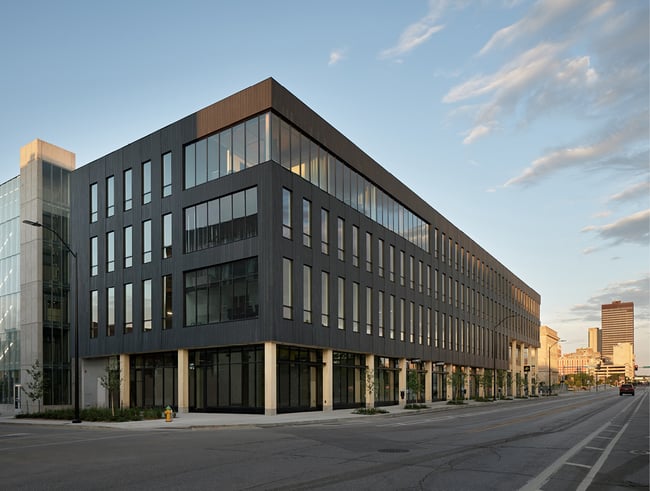Renovating vs. Building New: How to Determine

When starting a building project, many owners wonder if they should renovate or invest in new construction. Some owners may have a building that no longer serves their needs but feel unsure if moving locations is the right solution. Others may be considering several site options, including greenfield land and existing buildings.
Both approaches have their benefits and drawbacks. While renovations are the most sustainable approach, new construction may better suit some projects.
We’ve helped countless owners make this decision, guiding them with space utilization and site selection studies. This article will help you by discussing the pros and cons of renovating and building new, as well as the services an architect can offer to guide decision-making.
Pros and Cons of Renovating
Renovating an existing building offers many benefits. First, it is the most sustainable approach to design and construction. The built environment is responsible for nearly 40% of global greenhouse gas emissions. 13% of these emissions are attributed to materials and construction.
The most sustainable building is one that already exists. Any opportunity to reuse existing carbon-intensive materials like steel and concrete benefits the planet and lowers your project’s embodied carbon footprint.
Often, existing buildings are in prime locations near amenities, especially in larger cities. Renovations and adaptive reuse projects can help maintain a community’s character, connect to its history, and preserve valuable greenfield land, like farms and wildlife habitats. Building reuse can also increase density, creating more vibrant, connected communities.

Reusing existing buildings can help maintain walkable, dense communities.
At the same time, renovations can offer financial benefits. Along with potential decreased construction costs, many reuse projects benefit from government funding.
The Federal Historic Tax Credit program, for example, can cover up to 20% of a project’s renovation expenses. You may also find funding at the local level, including Tax Increment Financing. Some municipalities will even cover or split the cost of a feasibility study to help you determine potential renovation expenses.
Although renovating provides many benefits, it’s not without drawbacks. Older buildings may require remediation to remove hazardous materials like asbestos and lead, potentially increasing construction costs. You may also need to invest time and money into getting the building up to modern code and accessibility standards.
At the same time, a renovation can limit flexibility. You must work within the building’s existing conditions, creating additional constraints for your project.
Constraints can be beneficial, however. Existing conditions can help you parse your “wants” from your “needs” and narrow your project’s scope to the most essential elements.
Pros and Cons of Building New
For some projects, new construction may be a better option. The most obvious benefit is flexibility. When building new, constraints are limited to your budget and site.
You have a greater range of options for each design decision. For example, on a renovation, mechanical system options may be limited due to existing floor-to-floor heights. With a new building, you can design the building to fit your chosen system.
Similarly, you can have a wider range of options for exterior cladding, interior finishes, and other aesthetic design decisions. While existing buildings can provide a unique character, constraints can limit possibilities.

Building new can provide more options for materials and exterior treatments.
For developers, new construction gives you more control over your pro forma. You can design the building to maximize leasable space and better estimate the return on investment.
Despite the benefits, building new is less sustainable, and in many cases, more expensive than renovations. There are fewer financial incentives available as well.
While remediation is less likely on new projects, some site work may be necessary before breaking ground. For example, some building sites may require soil remediation to remove hazardous materials, especially if the site had a previous use.
How an Architect Will Guide Decision-Making
On any project, we recommend considering both options. Although building new or renovating may seem appealing, the other option may better suit your project and goals.
An architect can offer many services to help you with decision-making. For example, space utilization studies work well for clients currently occupying a building.
The study involves surveying occupants and visiting the site to gain an understanding of your operations and everyone’s day-to-day experiences. Your architect will observe how space is used and compile this data into a report for your building committee.
In some cases, a new building may be unnecessary. You may only need to reconfigure your existing space and find ways to use it more efficiently. Although it may feel like you’ve outgrown your current space, you may just be underutilizing it.
If considering several site options, your architect can complete a site selection study. Research begins by hosting a workshop to set goals and criteria. Your architect will present some high-level factors to consider, including:
- Sustainability
- Daylighting/views
- Flexibility
- Amenity access
- Visibility
- Initial cost
After ranking these criteria, your architect will form a matrix to evaluate and score your site options. This research may be coupled with feasibility studies of existing buildings.
Your architect can assess existing conditions to determine the opportunities and constraints each building presents. With cost estimates, you can evaluate if renovating fits your goals and budget.
Learn More About Architectural Services
Most building owners face the question of whether to renovate or build new. While new construction may seem appealing, renovating is always a viable option worth considering.
Reusing existing building stock helps reduce carbon emissions, preserve community character, and increase urban density. However, due to additional project constraints, it may not fit everyone’s goals.
An architect can guide you through this decision with space utilization, site selection, and feasibility studies. These services are outside the scope of basic architectural services and may be charged separately. Learn more by reading about the difference between basic and supplemental services.